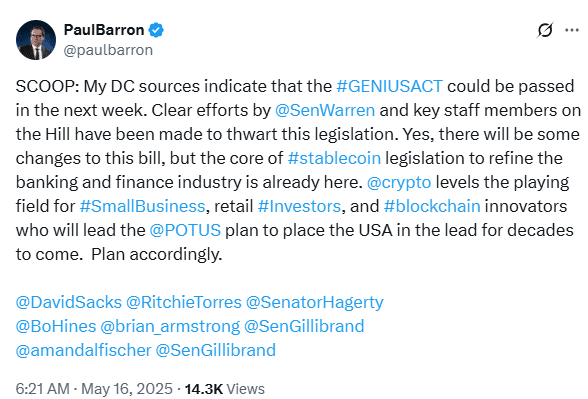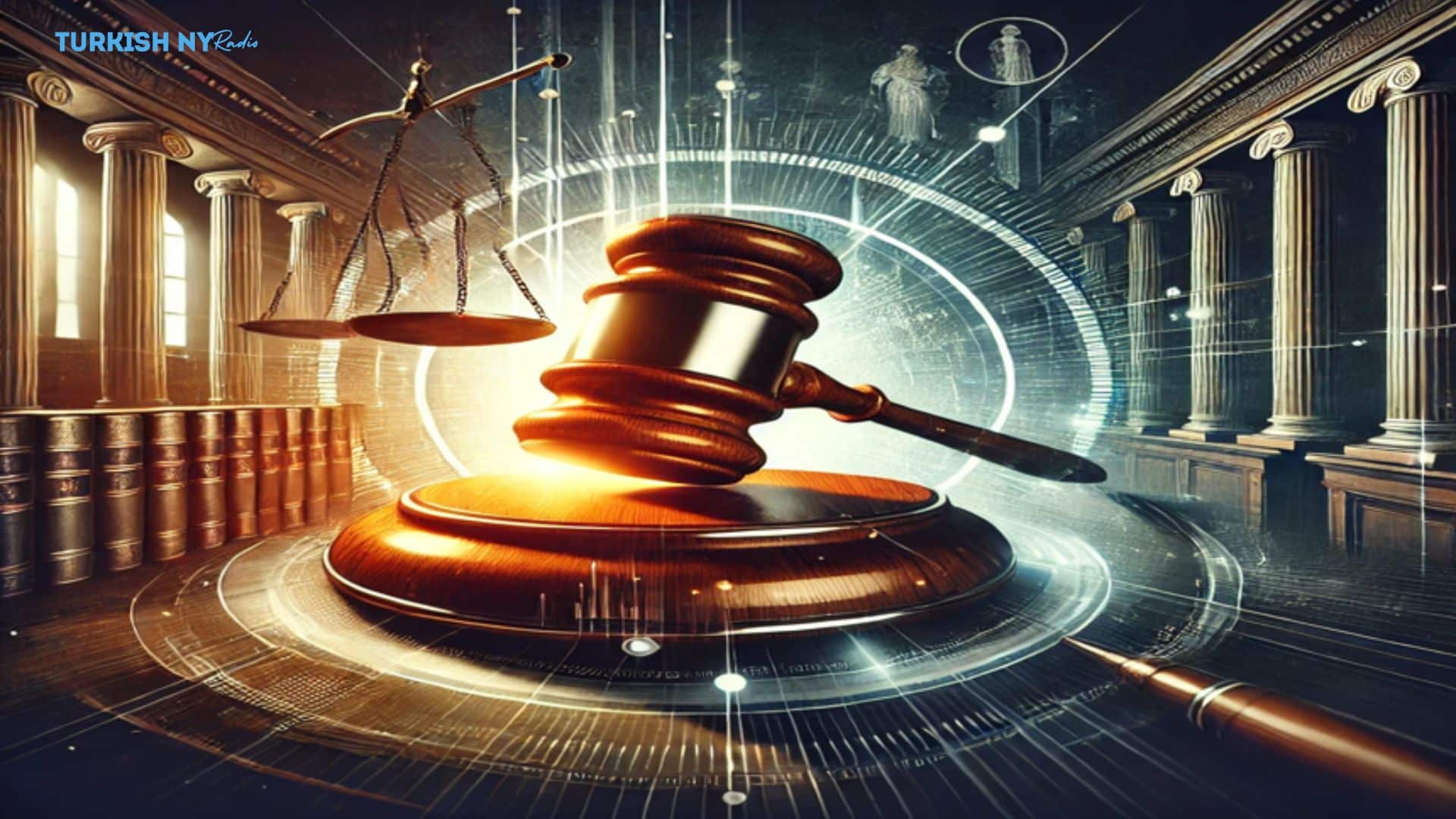A new bipartisan bill called the GENIUS Act is preparing to change the way stablecoins are regulated in the United States. This legislation, created for digital currency issuers, has recently picked up pace on Capitol Hill.
In Paul Barron’s view, the bill could make it through Congress next week, and revised drafts are now making the rounds in Washington.

GENIUS Act Gains Momentum
Senators Kirsten Gillibrand and Cynthia Lummis introduced the GENIUS Act, short for “Guiding and Empowering the Nation for Innovation in U.S. Stablecoins,” in March 2024.
It aims to bring stability and clarity to the rapidly expanding stablecoin market, which now exceeds $205 billion in value. On May 15, 2025, FOX journalist Eleanor Terrett confirmed that a new draft of the bill with bipartisan amendments is under review, signaling a final push before a Senate vote.

Focus on Innovation and Safety
This bill isn’t just about regulation, it’s about modernizing the U.S. financial ecosystem to compete globally. Supporters say the GENIUS Act balances innovation with accountability. It allows crypto developers and startups to build within the U.S. rather than flee to more flexible overseas jurisdictions.
While empowering innovation, the bill also includes strong guardrails to prevent financial misconduct and protect consumers. One of its central goals is to make sure smaller crypto companies can access the same financial tools and legal protections as large institutions.
Restricting Big Tech’s Role in Finance
Among the most notable amendments are new restrictions on Big Tech companies. The revised text introduces limitations that bar major tech firms like Meta, Amazon, and Google from issuing stablecoins unless they comply with stringent regulatory standards. These include mandates around financial risk management, consumer privacy, and fair business conduct.
The move reflects growing concern over Big Tech’s dominance in multiple sectors and the potential risks of allowing these firms to extend their influence into digital currencies.
Misleading Claims and Branding
The amendment ensures that stablecoin companies cannot be deceptive with their branding. Any statement about the support of the federal government or having FDIC insurance must be factual. Marketing related to stablecoins cannot mention the USG or United States Government, avoiding any confusion for people who are new to the field.
Strengthening Federal Reserve Protections
Another core amendment includes “master account guardrails,” which prevent unstable or unqualified firms from gaining access to Federal Reserve services. This provision aims to maintain the integrity of U.S. monetary infrastructure by ensuring only vetted entities can interact directly with central bank systems.
Expanding Oversight and Ethical Boundaries
It also includes additional ethical rules and closer monitoring by the government. Its rules on conflict of interest apply to everybody in the ecosystem, even people like Elon Musk and other government employees with a high profile. Through this bill, the industry is expected to uphold higher ethical and transparent standards.
A revised version gives more power to the treasury and stricter fines for those caught breaking the law. This is considered vital in dealing with misconduct in finances promptly.
Bankruptcy Protections Still in Review
One provision still under discussion is the inclusion of bankruptcy protections for stablecoin holders. If approved, this section would guarantee that consumers’ assets are protected even in the event of issuer failure.
While not yet finalized, it represents another step toward strengthening consumer trust in the digital asset space.
High Stakes in the Senate
The GENIUS Act is currently at the most important point in its progress. After the revisions, the Senate may take a vote on the document in just a few days. According to Rule 13, if it fails to pass through the next attempt, everybody must agree before it can be discussed again. That means this upcoming vote may be the last chance to reform stablecoins in 2025.
Conclusion
Whether one views it as long-overdue regulation or a groundbreaking policy for fintech, the GENIUS Act represents a defining chapter in America’s crypto journey.
By setting the groundwork for responsible innovation, it could provide the stability, fairness, and direction the industry needs to thrive. The U.S. now stands on the edge of a new era in digital finance, with the GENIUS Act as its potential cornerstone.
Frequently Asked Questions (FAQ)
1- What is the GENIUS Act?
The GENIUS Act stands for *Guiding and Empowering the Nation for Innovation in U.S. Stablecoins* and aims to regulate stablecoin issuance in the U.S.
2- Who introduced the GENIUS Act?
The bill was introduced by Senators Kirsten Gillibrand (D) and Cynthia Lummis (R) in March 2024.
3- What are stablecoins?
Stablecoins are digital assets pegged to traditional currencies like the U.S. dollar, designed to reduce price volatility in crypto markets.
4- Why is Big Tech restricted in the bill?
To prevent conflicts of interest and monopolistic behavior, Big Tech firms face limits on stablecoin issuance unless they meet strict regulatory requirements.
Appendix: Glossary of Key Terms
GENIUS Act – GENIUSAct is to help protect consumers and encourage more innovation by focusing on rules for stablecoins.
Stablecoin – A stablecoin is a type of cryptocurrency that tries to maintain a fixed value relative to the U.S. dollar.
Bipartisan Amendment – A bipartisan amendment gathers support from both the left and right sides of the political aisle.
Master Account – A financial account that allows institutions to access Federal Reserve payment systems directly.
FDIC Insurance – Federal protection that insures bank deposits up to a certain limit, often misrepresented in crypto marketing.
Rule 13 (Senate) – A rule implemented where all Senators must agree before reopening a bill for another vote.
References
CoinPedia – coinpedia.org
Cryptotime – cryptotime.io











































































































